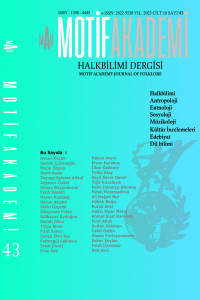Abstract
Öz: Batı resmi, başlangıçta insana ilişkin betimleme çabasını, inanç sistemleri üzerinden düşmanlaştırma ya da yüceltme gibi iki karşıt uçta, insanın sınıflandırılması yoluyla gerçekleştirmiştir. Batıda bu anlam da düşman yaratma çabası üzerine kurulu her türden imgeye rastlamak olasıdır. Bu, modern dönemin sonuna kadar giderek yoğunluğunu yitirmiş, ideolojik ve eleştirel biçimleme çabasına dönüşmüştür. Batılı anlam da Türk resmi gelişim süreci içerisin de, batıdan elde ettiği biçim ve renk ilişkisini kendi görsel birikimi ile kaynaştırması Batıyla doğrudan etkileşimde bulunabildiği zamanlar da olanaklı hale getirebilmiştir. Araştırma Batı da izini rahatlıkla sürdüğümüz fizyonominin, Türk resminde nasıl bir karşılık bulduğu ya da onu nasıl etkilediği üzerine odaklanmaktadır. Ayrıca araştırmanın önemli bir diğer amacı, fizyonominin ortaya koyduğu insana ilişkin biçimsel yorumun yardımıyla, Türk ressamının insana nasıl baktığını ve nasıl yorumladığını ortaya koymaya çalışmaktır. Fizyonominin tarihsel geçmişinin Aristoteles’e dayanması ve İslam inancında da fizyonomiye benzer çabaları nedeniyle, sadece Batılı anlam da Türk Resim Sanatı değil aynı zaman da minyatürler de örneklerle incelenmiştir. Yüzden niyet okumanın biçimsel verileri, seçilen portreler yoluyla karşılaştırılmış, fizyonomi bağlamında seçilen portrelere ilişkin değerlendirmeler yapılmıştır. Bu sonuçlar, Türk Resim Sanatının insana ilişkin yorumlarını ve ona atfettiği anlamın kendine özgün olduğunu göstermektedir.
Keywords
References
- Aleskerli, A. (2002). Yüz okuma sanatı. İstanbul: Selis Kitap.
- And, M. (2007). Minyatürlerle Osmanlı- İslam mitologyası. İstanbul: YKY.
- And, M. (2021). Osmanlı tasvir sanatları 1: Minyatür. İstanbul: YKY. Aristoteles. (1955). Minor works. (çev.: W. S. Hett). London: William Heinemann LTD.
- Eco, U. (2009). Çirkinliğin tarihi. (çev.: A. U. Ergün vd.). İstanbul: Doğan Kitap.
- Fahreddin, İ. (1933). Fizyonomi. İstanbul: Tefeyyüz Kitabhanesi.
- Giray, K. (1994). Türk resminde soyut eğilimler ve 10’lar grubu, Türkiye’de Sanat Dergisi, 1994, 12 (ocak- şubat), 67- 68.
- Göka E. - Beyazyüz M. (2012). Gerçek insanın yüzünde yazar mı? İstanbul: Timaş Yayınları.
- Güngör, E. (1996). İslam tasavvufunun meseleleri. İstanbul: Ötüken Neşriyat.
- Henderson, G. E. (2016). Çirkinliğin kültürel tarihi. (çev.: A. M. Çavdar). İstanbul: Sel Yayıncılık.
- Hogarth, W. (1753). The analysis of beauty. London: J. Reevees.
- Tansuğ, S. (1988). Türk resminde yeni dönem. İstanbul: Remzi Kitabevi.
PHYSIOGNOMY / ILM- I SIMA/ FIRÂSET IN THE EFFORT TO DEPICT HUMAN BEINGS IN TURKISH PORTRAIT PAINTING
Abstract
Abstract: West painting initially carried out its attempt to describe human beings through the classification of humans on two opposite extremes, such as enmity or sublimation over belief systems. In the West, in this meaning is also likely to come across all kinds of images based on the effort to create enemies. This gradually lost its intensity by the end of the modern period and turned into an ideological and critical formative effort. Although the western meaning is also in the process of Turkish Painting development, it has been possible for later times to fuse the form and color relationship obtained from the west with its own visual accumulation. Our research focuses on the influence of physiognomy, which we can easily trace in the West, how corresponds to or how influences Turkish painting. In addition, another important purpose of the research is to try to reveal how the Turkish painter looks at people and how he interprets them with the help of the formal interpretation revealed by Physiognomy with sample paintings. Due to the fact that the historical background of physiognomy dates back to Aristotle, not only the Western meaning of Turkish painting, but also miniatures have been studied with examples. The formal data of reading intentions from the face were compared with the selected portraits, and evaluations were made on the selected portraits in the context of physiognomy. These results show that the interpretations of Turkish Painting about human and the meaning attributed to human are unique to itself.
Keywords
References
- Aleskerli, A. (2002). Yüz okuma sanatı. İstanbul: Selis Kitap.
- And, M. (2007). Minyatürlerle Osmanlı- İslam mitologyası. İstanbul: YKY.
- And, M. (2021). Osmanlı tasvir sanatları 1: Minyatür. İstanbul: YKY. Aristoteles. (1955). Minor works. (çev.: W. S. Hett). London: William Heinemann LTD.
- Eco, U. (2009). Çirkinliğin tarihi. (çev.: A. U. Ergün vd.). İstanbul: Doğan Kitap.
- Fahreddin, İ. (1933). Fizyonomi. İstanbul: Tefeyyüz Kitabhanesi.
- Giray, K. (1994). Türk resminde soyut eğilimler ve 10’lar grubu, Türkiye’de Sanat Dergisi, 1994, 12 (ocak- şubat), 67- 68.
- Göka E. - Beyazyüz M. (2012). Gerçek insanın yüzünde yazar mı? İstanbul: Timaş Yayınları.
- Güngör, E. (1996). İslam tasavvufunun meseleleri. İstanbul: Ötüken Neşriyat.
- Henderson, G. E. (2016). Çirkinliğin kültürel tarihi. (çev.: A. M. Çavdar). İstanbul: Sel Yayıncılık.
- Hogarth, W. (1753). The analysis of beauty. London: J. Reevees.
- Tansuğ, S. (1988). Türk resminde yeni dönem. İstanbul: Remzi Kitabevi.
Details
| Primary Language | Turkish |
|---|---|
| Subjects | Painting History |
| Journal Section | Articles |
| Authors | |
| Early Pub Date | September 19, 2023 |
| Publication Date | September 19, 2023 |
| Submission Date | December 14, 2022 |
| Published in Issue | Year 2023 Volume: 16 Issue: 43 |

